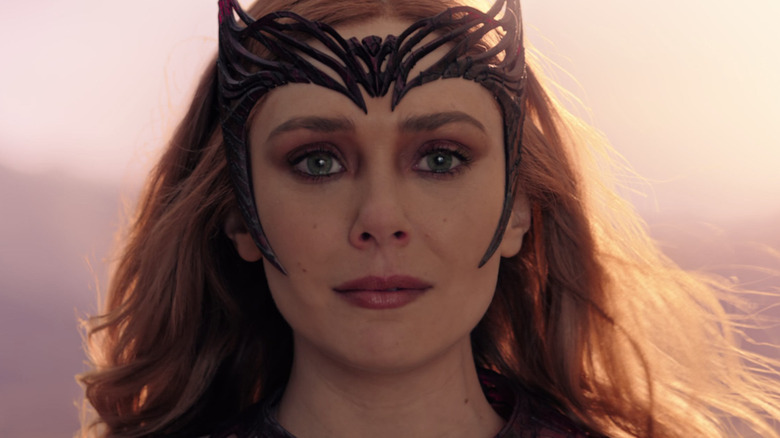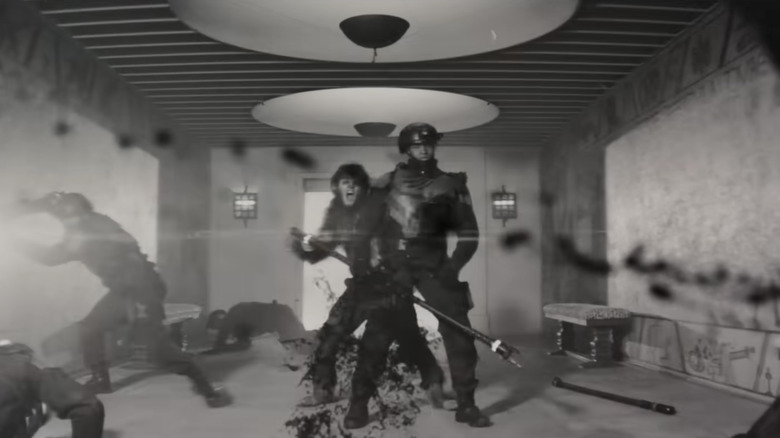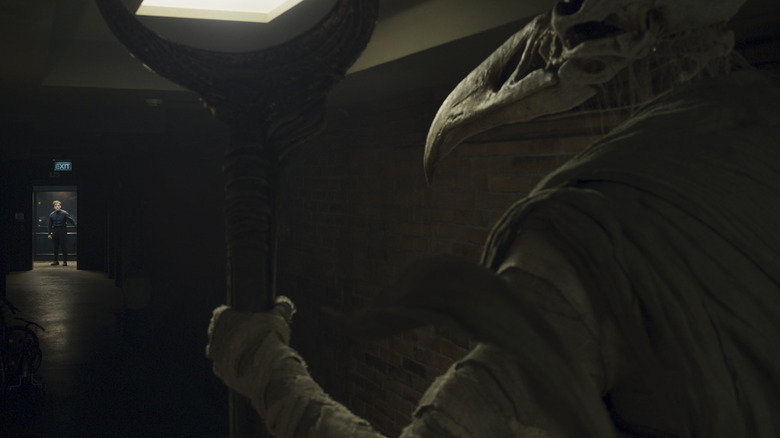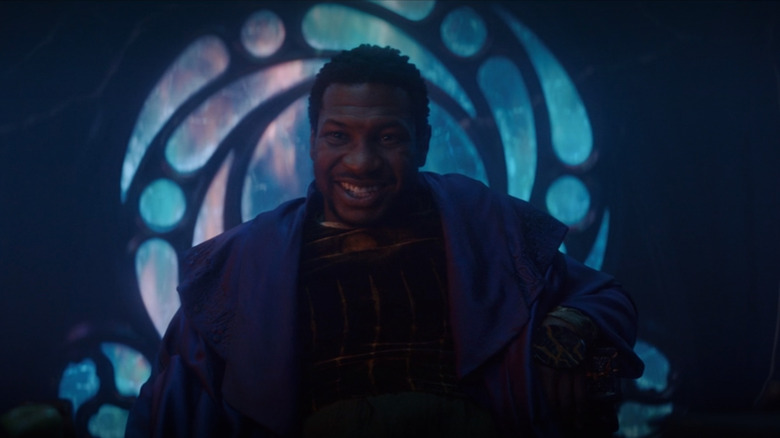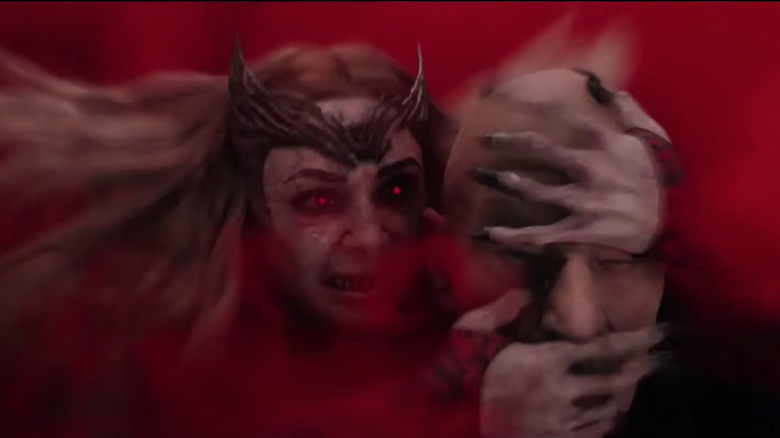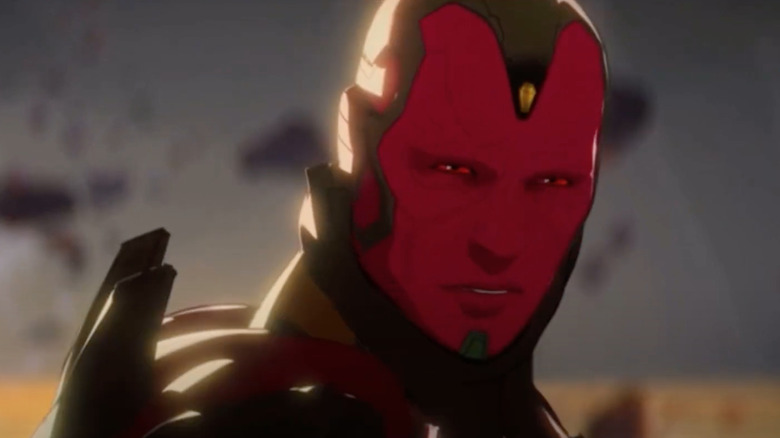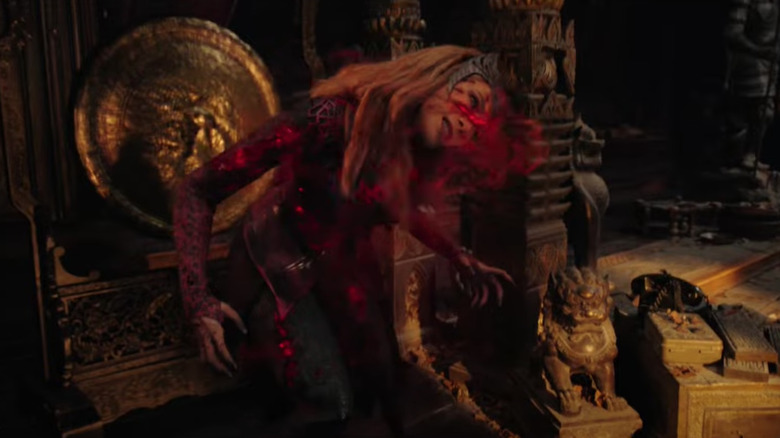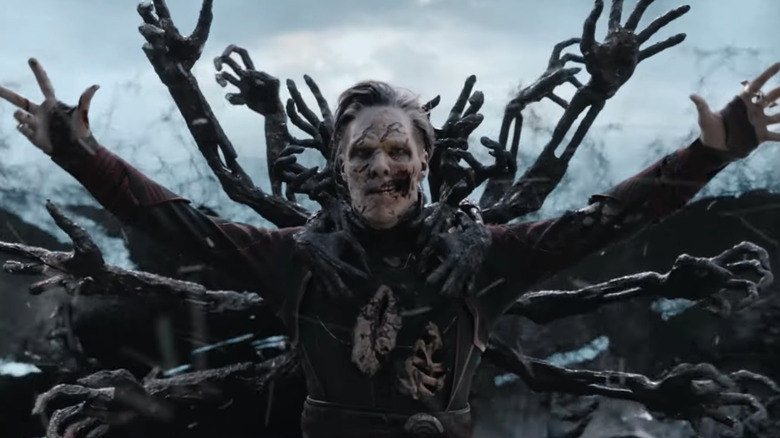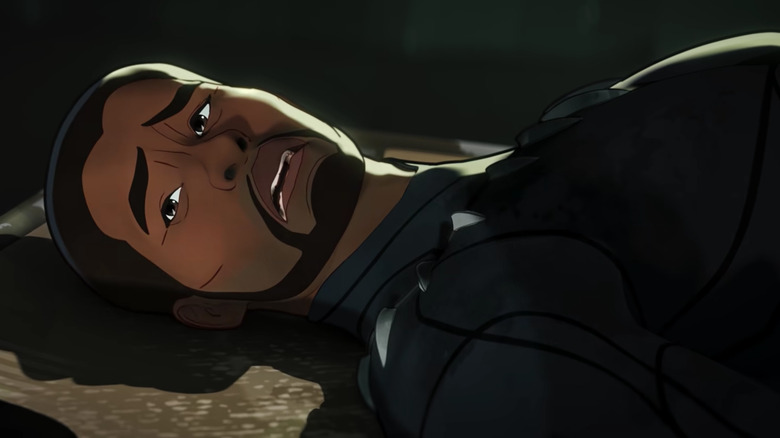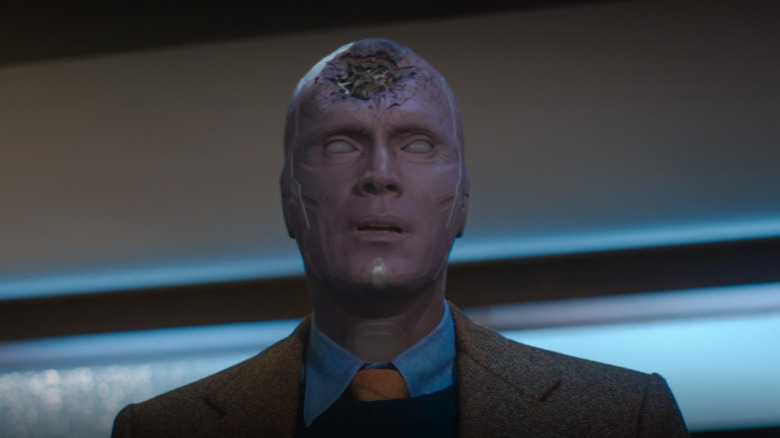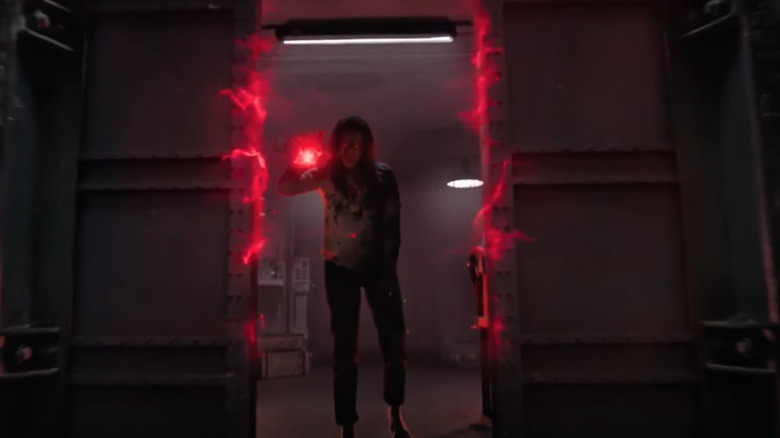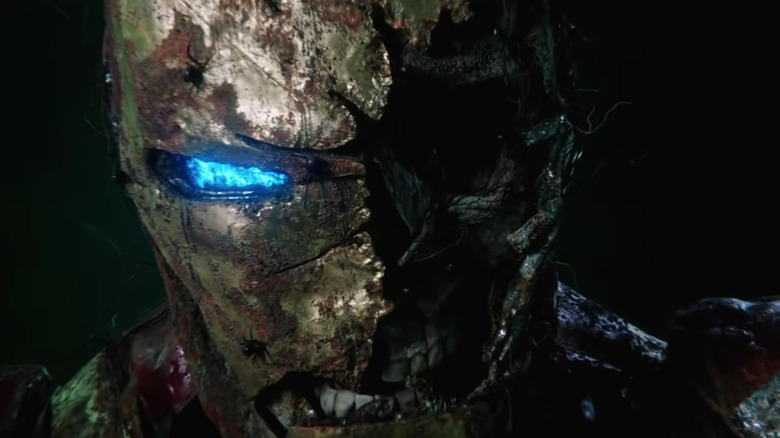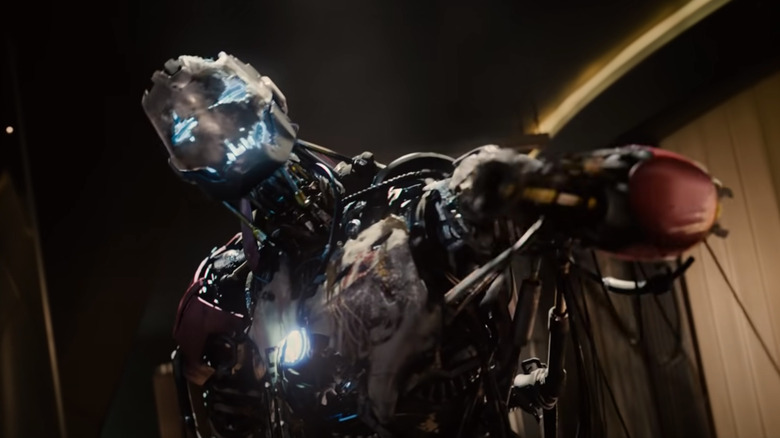The 12 Most Horrifying Moments In The MCU Ranked
The Marvel Cinematic Universe has enjoyed astonishingly exponential growth since its first installment hit theaters all the way back in 2008. Each phase has introduced new heroes, villains, and comic book adventures to an eager public. The MCU also experiments with genre as a way to put fresh spins on their stories. We've seen fourth-wall-breaking satire on "She-Hulk: Attorney at Law," espionage-driven spy thrills in "Captain America: The Winter Soldier," space-faring action-comedy in "Thor: Ragnarok," and sweeping drama in "Black Panther."
Recently, Marvel has started to bring outright horror into its potent storytelling mix. Shadows of this immortal genre are evident in earlier MCU productions, including the blockbuster "Avengers" films and even Spider-Man's teen-centric misadventures. But Phase 4 brings nightmares like never before. They bleed onto television in "WandaVision" and the remarkable Halloween special "Werewolf by Night," and light up the big screen in "Doctor Strange in the Multiverse of Madness." This opens the door for even more scary tales to ooze into the MCU, especially in upcoming productions like "Marvel Zombies," "Blade," and other hair-raising tales.
This engagement with the bloodiest genre around allows the MCU to explore all kinds of terror, from cosmic frights at the hands of dimension-hopping tyrants to visceral body horror (R.I.P. Black Bolt.) But which scary scenes are the most truly blood-curdling? We're here to find out. These are the 12 most horrifying moments in the MCU, ranked.
12. The Werewolf's blood-curdling slaughter
"Werewolf by Night" is an adventure in full-blown horror. This blood-splattered Halloween special even pays homage to early 1930s movie monsters like the Wolfman and Dracula in its opening scene. A stand-out production boasting incredible effects, it's shot entirely in black-and-white. This is gorgeous, and also makes the sickening blood and gore more palatable, so even younger audiences can enjoy the gruesome thrills on offer.
"Werewolf by Night" is the MCU directorial debut of esteemed composer Michael Giacchino, who also arranged the haunting score. His distinctive style complements star Gael García Bernal perfectly. As Giacchino detailed in an interview with Discussing Film, "Werewolf by Night" is practically bursting with practical effects. This honors the horror movies of old, and also allows Bernal's skill to shine through. "It's always fun to watch a CG monster," Giacchino remarked. "Yes, absolutely. I get it. I love that as well. But for this, this was such a personal story that I wanted someone real — someone that when I looked in their eyes, I was looking into the eyes of a human behind that monster."
Such depth of humanity makes the Werewolf's ferocious carnage even more gripping: You truly see the rage in Bernal's eyes. This grounds the unforgettable scene of his slaughter. Strobe-like lighting briefly allows the audience a second to breathe before more vicious slashes ensue. The moment is made even more scary when blood is strewn across the camera's lens.
11. Khonsu's haunting chase
"Moon Knight" starts sending shivers down viewers' backs in its earliest episodes. Without much insight into the Egyptian god Khonsu, fans are left to quake in the shadow of his mysterious power. This lack of knowledge extends to our lead character, Steven Grant (Oscar Issac), which is actually only one of the many confusing identities our protagonist possesses.
Grant is often bewildered by the strange events occurring around him, which translates into the audience feeling equally perplexed — and, oftentimes, scared out of their wits. Khonsu's pursuit of Steven is an especially spine-tingling moment, as the god displays a relentless willingness to frighten the gift shop employee until he complies with his wishes. In a dimly lit storage facility, Khonsu appears to Grant, seeking to merge with him and become the titular Moon Knight. He frighteningly materializes between flickering lights before beginning his pursuit down a long, dark hallway. This sends Grant off screaming, but no matter how fast or far he runs, he can't escape. Khonsu doesn't give up easily.
This scene features an interesting filmmaking detail used profusely in older horror films: It highlights Grant's horrified scream with a freeze-frame reaction shot. It also illuminates Khonsu in bone-chilling detail as he towers over Grant, his voice (provided by F. Murray Abraham) booming in the close confines. These eerie details set "Moon Knight" apart from the rest of the MCU as a unique and ghastly journey into brain-bending horror.
10. He Who Remains' gleeful arrival
"Loki" became one of the most surprisingly emotional and consequential Disney+ series by introducing the MCU's next major villain. Far ahead of the premiere, news broke that Jonathan Majors had been cast as the formidable Avengers enemy Kang the Conqueror (via The Hollywood Reporter). When "Loki" began airing, it quickly consumed fans with new concepts, worlds, and details to discuss. Variants of our favorite characters, wacky alternate realities, and the grand and glittering multiverse are all on offer here. And then, when "Loki" Season 1 comes to its end, it reveals one more trick up its sleeve.
Episode 6, "For All Time. Always.," contains a breathtaking surprise: The casual reveal of Kang, in variant form. This iteration refers to himself as He Who Remains. He informs Loki (Tom Hiddleston) and his sarcastic blonde variant Sylvie (Sophia Di Martino) that his death will bring an even stronger form to life, who is far more fearsome. Comic fans, and those who immediately recognize Majors, shudder with the realization that this will finally bring forth Kang the Conqueror, one of the Marvel universe's most formidable villains.
When Sylvie gives into her anger and stabs He Who Remains, she fulfills his prophecy and sets this variant form free. His death allows the birth of the Conqueror, who will eventually stand poised to decimate the MCU. This makes He Who Remains' display of glee even more harrowing. He's stabbed — and he's happy about it.
9. The Scarlet Witch executes Professor X
"Doctor Strange in the Multiverse of Madness" is the MCU's first straight-up horror movie. Helmed by experienced horror visionary Sam Raimi, this movie scares audiences deep into their theater seats. Elizabeth Olsen's depiction of the grief-stricken Scarlet Witch, who has become consumed by the malevolent Darkhold, is a tour de force of fright. Wanda doesn't just go bad — she heads into ultimate villain territory.
For one thing, Wanda possesses a variant form of herself in an effort to infiltrate that variant's universe, an unpardonable sin against the multiverse. For another, she murders Marvel's heroic Illuminati while only exerting a fraction of her full power. Wanda begins by imploding Black Bolt's (Anson Mount) brain by using his abilities gruesomely against him. She then unleashes even more chaos by unraveling Mr. Fantastic (John Krasinski), slicing Captain Carter (Hayley Atwell) in half with her own shield, and crushing Captain Marvel (Lashana Lynch) beneath an enormous statue.
But Wanda saves her most vicious murder for last. Professor Charles Xavier (Patrick Stewart) — in his iconic yellow hover chair — announces that enough is enough. The two psychics proceed to face off on the mental plane. Xavier attempts to rescue the possessed Wanda, who's trapped in rubble. He gets closer and closer to reaching her — but then the sinister Wanda leaps out of a cloud of red smoke and snaps his neck, killing him instantly. This brutal murder's up-close nature makes it all the more arresting.
8. Ultron sees through to the Watcher
The wildly imaginative animated Disney+ series "What If...?" takes audiences through the complex layers of the multiverse. The premise sets it up to be an inconsequential (in terms of the main MCU timeline) narrative, which transports our favorite heroes and villains to new and exciting universes. The mysterious interdimensional being known as the Watcher (Jeffrey Wright) is our guide to it all, explaining the stories of these variant characters and universes. He's safely obscured from the proceedings as an observer and narrator, bound to monitor their choices without ever interfering. But this playful idea enters scary new territory when it takes classic Avengers villain Ultron (Ross Marquand) down a new path, where he not only successfully merges with Vision's body, but also obtains all six Infinity Stones.
Ultron's heightened abilities give him awe-inspiring power. He's so mighty, he ascends to a new level of consciousness, which allows him to hear the Watcher's narration. In one shocking moment, he becomes able to see through the story itself, turns his head, and locks eyes with the Watcher. This terrifies the Watcher to his very core. Audiences sympathize — it also feels like Ultron sees the viewers with his unflinching gaze. If you feel prompted to shut off your TV, we understand. Ultron is rarely scarier than he is in this moment, when he becomes powerful enough to transcend fiction itself. Talk about a superpower.
7. Wanda's unsettling new abilities
Wanda's Darkhold trip in "Doctor Strange in the Multiverse of Madness" transforms the reality-bending Avenger into an implacable, revenge-driven, god-like monster. The Scarlet Witch's dark turn showcases an abundance of grisly new powers, which are all put to use in her unstoppable pursuit of dimension-hopping teenager America Chavez (Xochitl Gomez). One ability is put on particularly flashy display when Wanda uses reflections in water to escape Doctor Strange's infamous mirror dimension.
But Wanda doesn't exit this dizzying realm in one simple leap. Director Sam Raimi builds the suspense to an agonizing peak as Wanda pulls defenseless guards to their doom through reflective puddles. Her hands rush out like those of a trapdoor spider, killing these warriors in the blink of an eye. This gruesome campaign of slaughter only ends when she sickeningly contorts her body through a reflective gong. When she emerges, she's broken and torn, crawling on limbs that bend the wrong way. But then, glowing with power, she wrenches her bones back into place, mends the cracks in her flesh, and stands up straight. Like the best horror movie monsters, she is inescapable.
In this scene, Raimi leans heavily into his love of body horror. There's something truly terrifying about watching Wanda pull herself forward with an evidently broken spine. The fact that this is swiftly topped by the sight of her forcing said spine back into place says it all.
6. Doctor Strange's reanimated corpse
Superhero fans might know him best as the director of the 2000s "Spider-Man" trilogy, but Sam Raimi first got his creepy kicks creating the "Evil Dead" franchise. His use of practical effects and commitment to depicting the undead in authentically macabre fashion translates well to Doctor Strange's corner of the MCU, as it turns out. "Doctor Strange in the Multiverse of Madness" is a non-stop thrill ride of gory imagery, terrifying creatures, and utterly unstoppable evil. This is never more clear than when Strange possesses his variant's corpse and launches himself into battle.
This reanimation puts Doctor Strange in an entirely new light and cements the film's horror bonafides. Zombie Strange is straight-up gross looking: His face is eaten away with rot, his limbs move like those of an old puppet, and his skin has grown gray and pallid. Then he ups the ante considerably by weaving the souls of the damned, who've come to condemn him for possessing the variant's body, into an infernal cloak, which allows him to reach the battle. In less capable hands, this could either have been too scary for Marvel's mainstream audience or, even worse, too silly, sucking the scares right out of the story. But Raimi's ability to incorporate a certain level of camp with utterly jaw-dropping horror makes his vision of an undead Doctor Strange into one of the coolest and most horrifying things to ever come out of the MCU.
5. Vision's disturbing meal prep
Marvel's "What If...?" adapts one of the most frightening versions of the Avengers by tackling Robert Kirkman's infamous "Marvel Zombies" comics in stand-out episode "What If...Zombies?!" This installment features a deadly plague, which infects the superhero team, monstrously transforming them into flesh-eating zombies. Surprisingly, the episode entirely embraces the comic's gritty celebration of gore: Blood is spilled, noses rot off, and teeth are bared.
But the zombies aren't the most horrifying part of the episode — it's the disturbing way the Avengers turn on each other, even without the virus. Vision (Paul Bettany) is the main antagonist of this installment: He holds Black Panther (Chadwick Boseman) captive as a food source for his beloved. This stunning realization is truly stomach-turning. Just the thought of a zombified Wanda consuming the Wakandan royal is awful — but seeing T'Challa's terrified face is way, way worse. The chaos magic-wielder has been turned into a flesh-eating corpse, who still has distressing access to her powers. This introduces an even graver danger to the remaining Avengers.
4. Wanda sees Vision's true form
"WandaVision" incorporates a myriad of television aesthetics over the course of its run, from cheery midcentury family hijinks to the lovably dysfunctional approach of '90s sitcoms. But things plummet into horror when Wanda turns around to answer a question from Vision, and is met with the awful reality behind her hex. She doesn't see her loving husband — she sees his corpse, reanimated to her will.
This moment alludes to her reclamation of Vision's body, which we see in subsequent episodes. Wanda has seen this face before, and she hasn't actually managed to block it out entirely. It also portrays Wanda's fracturing mental state, which is weakening her spell. Westview, the sunshiny suburban reality she's created, isn't impermeable. This jump-scare is a quietly forceful way of making us, and Wanda, face reality, if only for a moment. Vision is an empty shell, sustained only by Wanda's abilities, which finally unravel in the finale. No wonder the newly-crowned Scarlet Witch heads for the ominous Darkhold — we can't handle the sight of Vision's dead face either.
3. Wanda's terrifying tunnel chase
After massacring the Illuminati in "Doctor Strange in the Multiverse of Madness," the Scarlet Witch continues her undeterred pursuit of America Chavez. This sends the movie into truly classic horror territory: Wanda is the invulnerable monster relentlessly chasing the hapless victims, who just can't seem to shake her. By putting Wanda in this role, the movie scrambles audience's sympathies in a very effective way. We're sympathetic, because we know and love Wanda. But this also means we're all the more appalled by her chilling turn.
Things get especially horrifying when the Scarlet Witch chases our heroes through an industrial tunnel. She rips through door after door, limping from her injuries. This imagery brings Ultron's earliest form to mind — he too twitched and struggled to communicate his message — which makes her even more resonantly scary. She's also barefoot and covered in blood, rendering her a truly primal image of fear. Wanda's glowing red eyes convey not only her massive power, but also her intense rage: The Scarlet Witch is channeling pure fury as she wrenches open barrier after barrier. To some fans, this makes her an irredeemable villain. To others, it's a horrible, yet sympathetic, act. But it's sure to scare the living daylights out of just about everyone.
2. Peter sees an undead Iron Man
In "Spider-Man: Far From Home," the emotional return to the MCU after the monumental events of "Avengers: Endgame," Peter Parker (Tom Holland) struggles to cope in a Tony Stark-less world. While traveling through Europe on a class trip, he encounters the manipulative Mysterio (Jake Gyllenhaal). This fiend traps Spider-Man in a dizzying dream sequence, where he comes face to face with this unresolved fears. They take the gut-wrenching form of Tony's decaying corpse, complete with a cracked Iron Man helmet and a swarm of spiders that crawl out of his skull.
This unsettling image is one we can't easily turn away from. It piques our most morbid interest, but it also offers bizarre and potent closure. We see Tony's death and funeral in "Avengers: Endgame," yet it still doesn't seem quite real that he won't be returning for another film. His startling resurrection in "Spider-Man: Far From Home" makes it clear that Tony Stark is really, truly, and completely gone — and both Peter and the audience must find a way to cope.
1. Ultron's puppet strings
Marvel's stirring teaser trailer for "Avengers: Age of Ultron" introduces the titular android in a truly dreadful way. A dark arrangement of "I've Got No Strings," a jaunty little tune from Disney's 1940 classic "Pinocchio," plays as Ultron (James Spader) is introduced to the audience. This brings his mindset to the fore — he's just as free as Pinocchio. And his first act is to take over Tony's sentry robots, invade the Avengers' compound, and challenge Earth's mightiest heroes in their own home.
Ultron's immense power can be felt, even through the pathetically convulsing bot he inhabits. He derides the Avengers as pitiful puppets, unable to challenge his might. As he struggles to hold his machinery together, you might find yourself shifting uncomfortably in your seat — there's just something about his eerie movement that sets one's teeth on edge. Then, as the song lilts in the background, he growls, "There are no strings on me." This line still manages to chill the blood, even when you know Ultron doesn't get his way. It's one of the best bits of dialogue in the entire MCU, and its scariest-ever moment.
